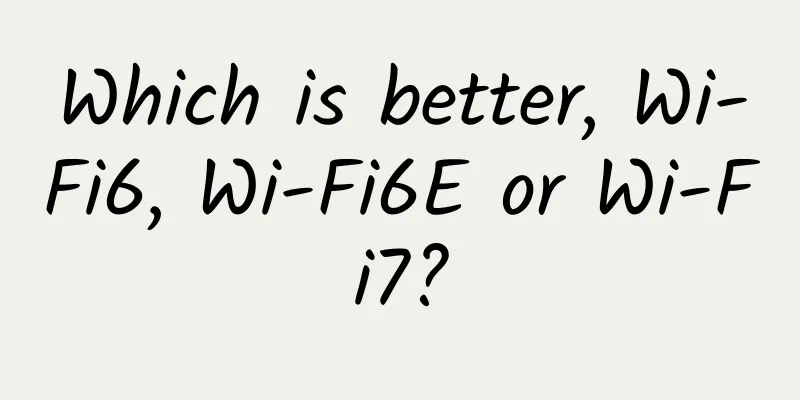After a year, Wi-Fi 6 has become standard. Here is everything you want to know

|
Back in September 2019, Apple officially released three new products: iPhone 11, iPhone 11 Pro and iPhone 11 Pro Max. In addition to highlights such as the rear triple-camera and A13 processor, the most noteworthy thing is that the entire iPhone 11 series supports Wi-Fi 6 technology. Since then, Wi-Fi 6 has attracted the attention of many netizens. In fact, when it comes to Wi-Fi 6, many friends are more familiar with 5G technology. 5G can be said to be the most popular communication technology at the moment. Whether it is the construction of 5G base stations by the three major domestic operators or the recent emergence of 5G mobile phones, everyone is looking forward to 5G to bring a better Internet experience. Compared with 5G, Wi-Fi, a wireless communication technology that we use every day, is not paid much attention to. For example, perhaps an elder will ask you if your mobile phone is 5G, but will not ask if the router is Wi-Fi 6. It can be seen that Wi-Fi 6 is not as well-known as 5G, but in fact Wi-Fi 6 technology and 5G have the same important position. So what is Wi-Fi 6? First, let's understand what Wi-Fi 6 is. As the name suggests, Wi-Fi 6 is the sixth generation of Wi-Fi technology, and 802.11ax is another name for it. In October 2018, the Wi-Fi Alliance officially incorporated Wi-Fi based on the 802.11ax standard into the regular army, and took the opportunity to promote 802.11ax to rename the Wi-Fi specification. The new standard 802.11ax was renamed Wi-Fi 6. Not only did the naming convention change, but a new icon was also used for Wi-Fi device network connections. Technically, Wi-Fi 6 can support both 2.4G and 5G frequency bands, and is the sixth generation of Wi-Fi iteration standard in the true sense. It has now replaced the 11n and 11ac products on the market. In addition, Wi-Fi 6 also brings a full version of MU-MIMO (supporting 8 terminals uplink/downlink MU-MIMO), and introduces OFDMA technology to achieve another parallel transmission capability that complements MU-MIMO, and is more flexible and practical than MU-MIMO. What are the advantages of Wi-Fi 6? When it comes to the advantages of Wi-Fi 6, the most prominent one is the significant increase in speed. You should know that the theoretical maximum speed of Wi-Fi 5 is 6.9Gbps, while Wi-Fi 6 can be increased to 9.6Gbps. In other words, in our daily Internet access, the Internet speed will be greatly improved. The higher speed is the first feeling of most people about Wi-Fi 6, but in fact, the advantage of Wi-Fi 6 is not just the speed. In addition to faster speeds, better performance in congested areas is another major advantage of Wi-Fi 6. In layman's terms, it solves the performance bottleneck in congested areas and provides a smoother Internet experience when multiple devices are connected. After all, in today's era of the Internet of Everything, multiple devices connecting to Wi-Fi at the same time can easily cause network lag, and Wi-Fi 6 can solve this problem very well. The reason is that Wi-Fi 6 uses two black technologies, OFDMA and MU-MIMO. Among them, OFMDA technology can divide the wireless channel into multiple sub-channels (subcarriers) to form frequency resource blocks. User data is carried on each resource block instead of occupying the entire channel, so that multiple users can transmit in parallel at the same time in each time period. Simply put, the OFDM solution of Wi-Fi 5 is to send vehicles according to orders. Regardless of the size of the goods, one order is sent for one trip, even if it is a small piece of goods, a vehicle is sent. This leads to low utilization of the carriages, low efficiency, and waste of resources. The OFDMA solution will aggregate multiple orders and try to get the trucks fully loaded on the road, greatly improving transportation efficiency. On the other hand, Wi-Fi 6 supports MU-MIMO, which is what we often call multi-user multiple-input multiple-output, allowing the router to communicate with up to 8 devices at the same time, and supports both uplink and downlink MU-MIMO, without the need to communicate in sequence; in contrast, although Wi-Fi 5 also supports MU-MIMO, the router is only allowed to communicate with four devices at a time, and only supports downlink MU-MIMO. This may be a bit abstract, let's use traffic as an example, it means that the road is expanded from 4 lanes one-way to 8 lanes two-way, and multiple devices are no longer like many vehicles waiting in line to exit from one exit. They can exit/enter from different roads at the same time and efficiently, instead of queuing up one by one, which greatly improves efficiency. In addition, another manifestation of Wi-Fi 6's power is that it is more energy-efficient. The reason why Wi-Fi 6 can help the development of the Internet of Things is that it supports TWT (Target Wakeup Time) technology. It allows APs to plan communications with devices, negotiate when and how long to wake up to send/receive data, and group terminals into different TWT cycles, reducing the time required to keep the antenna powered on to transmit and search for signals, which means reducing battery consumption and improving battery life performance, while also reducing the number of devices competing for wireless resources at the same time after waking up. In the future, smart water meters, smoke detectors, access control in smart building scenarios... machine tools, AGVs, in-and-out warehouse scanning equipment and other types of smart devices in smart factory scenarios can all access Wi-Fi. Thanks to TWT, each device can establish a "wake-up protocol" separately, and the terminal device will only enter the working state after receiving its own "wake-up" information, and will be in a dormant state for the rest of the time, which can save up to 7 times the battery power consumption. This makes some IoT devices that require high bandwidth possible. Overall, TWT technology shows Wi-Fi 6's determination to embrace the Internet of Things. Which is more important, Wi-Fi 6 or 5G? Which one is better, Wi-Fi 6 or 5G? I believe everyone must be very interested in this topic. Earlier, we introduced the Wi-Fi 6 technology and its advantages. I believe everyone has a deeper understanding of Wi-Fi 6. So, as 5G is on par with Wi-Fi 6, which one has more advantages? In fact, in our opinion, WiFi6 and 5G are not a matter of "fish and bear's paw", but are limited by time and commercial factors. Nowadays, many mainstream mobile phones have both. Compared with 5G, WiFi6 is a technical solution to the "localization" of short-distance wireless transmission. Including WiFi6, all protocols starting with 802.11 (including 802.11ax, ac, b, g, n, etc.) do not involve any controlled spectrum resources and are free and open. The frequency band where 5G is located is a spectrum resource that is controlled by the government and formulated by 3GPP and communication associations of various countries. The similarities between the two are that both Wi-Fi 6 and 5G use OFDMA and MU-MIMO technologies, which have increased bandwidth and access capacity by 4 times compared to their predecessors. The two are essentially very different. Wi-Fi 6 is actually a wireless technology with a smaller coverage range, and the transmission power of the router determines the coverage range of Wi-Fi 6. Due to power and spectrum resource limitations, most routers are more suitable for covering a certain indoor scene. The 5G network is a communication technology that is uniformly planned and managed by the country. It is generally deployed outdoors, uses high-frequency signals, has a wide range, and is not easily interfered with. Therefore, 5G is mainly used in public network access and Internet infrastructure access. Therefore, Wi-Fi 6 and 5G are not a matter of "having your cake and eating it too". You need to choose the appropriate solution based on your needs. Do you need to replace your router with Wi-Fi 6 now? Seeing that Wi-Fi 6 is so powerful, do you really need to upgrade your home router now? In fact, it depends on your specific usage needs and specific analysis of specific issues. One situation is that your mobile phone, laptop and other terminals already support the Wi-Fi 6 standard. In this case, we recommend that you upgrade your home router as well. After all, as the output end of the home wireless network, if the router does not support Wi-Fi 6, then the terminal support is useless. When purchasing, you should also make sure that it says on the router box that it supports 802.11 ax or Wi-Fi 6. Another situation is that the smart terminal for Internet access does not currently support Wi-Fi 6, but the wireless standard supported by the router at home is outdated, such as Wi-Fi 4. If this is the case, we suggest that you upgrade your home router to a new product that supports the Wi-Fi 6 standard in one step. After all, nowadays, Wi-Fi 6 has become standard for newly released mobile phones, laptops and other devices. If you need to upgrade your router, you can consider buying a wireless router that supports Wi-Fi 6. Looking at these two situations, it is right to buy a Wi-Fi 6 router, after all, it is a popular trend. Looking at the current Wi-Fi 6 router market, Wi-Fi 6 routers are emerging in an endless stream. The types range from home, e-sports to large-sized routers, and the prices range from hundreds to thousands. The product distribution of Wi-Fi 6 routers is relatively complete. However, compared with Wi-Fi 5 routers, they are still in the minority, but they are also showing a trend of gradually catching up. Faced with user demand for Wi-Fi 6 routers, the response measures of major manufacturers are also very different. Speaking of Wi-Fi 6 routers, ASUS routers must be mentioned. ASUS and Broadcom have strategically collaborated to launch the world's first Wi-Fi 6 router. Since then, several Wi-Fi 6 products with different positioning for segmented scenarios have been launched one after another, with prices ranging from thousands to thousands of yuan. It can basically be said that they are deployed in the mid-to-high-end market. Compared with ASUS, Huawei's Wi-Fi 6 routers are more around a few hundred yuan, and are more inclined to ordinary family use. Therefore, at the end of the year, we predict that ASUS will supplement its low-end router products, while Huawei will supplement some mid-to-high-end e-sports router products to supplement its own router product line. Final Thoughts In general, the characteristics of Wi-Fi 6 can bring users a smoother Internet experience, and it also has its own advantages over 5G. Nowadays, mobile phones, laptops and other terminal devices produced by major manufacturers have already made Wi-Fi 6 a standard feature, so it is natural to replace a Wi-Fi 6 router. However, at present, the layout of Wi-Fi 6 products by major router manufacturers is not perfect, so we boldly speculate that when manufacturers see the market demand, a large number of mid- and low-end Wi-Fi 6 router products will be launched at the end of this year, and Wi-Fi 6 routers will be quickly popularized within one or two years. The times are advancing, and so are routers? |
>>: H3C iMC leads the Chinese network management software market for three consecutive years
Recommend
Network Automation Market to Surge Over the Next Decade
According to the latest forecast from Future Mark...
ZJI: 580 yuan/month 2×E5-2630L, 32G memory, 480G SSD, 10M bandwidth, Hong Kong Confederation data center
ZJI is a well-known hosting company in the WordPr...
First time: China achieves major breakthrough in quantum relay
Recently, Duan Luming's research group at the...
Tong Yongyue from Yunfan Accelerator: What are some things you must know if you want to do media integration well?
The CCBN-BDF Forum was held at the same time as t...
Qianxinan Prefecture: Green "optical" network, a new style of government office
On a normal working day, sunlight shines through ...
Live broadcast and fan interaction is popular! Yunfan Accelerator will show you the live broadcast and microphone technology behind it
Preface: With the continuous upgrading of bandwid...
The three major operators' performance in the first half of 2021 collectively "rejuvenated": 5G drives value return and emerging business revenue growth is outstanding
[[418602]] The traditional communication business...
naranja: €16.2/year-AMD EPYC7763/2GB/30G NVMe/5TB/Netherlands VPS
This is the first time that the tribe has shared ...
CloudCone: Large hard disk VPS annual payment starts at $17.77, Los Angeles MC data center, KVM architecture
CloudCone is a foreign hosting company founded in...
SD-WAN brings new security challenges
Security is one of the top concerns for organizat...
Why are iOS and Android game data not interoperable? The truth is revealed
One day you get tired of it and want to switch to...
With these four tips, not only the guy next door, but even God can’t get access to your WiFi!
The world is so big, thank you for visiting me!! ...
SmartHost newly launched VPS distribution starting from $6.95/month, multiple data centers available
I received an email from SmartHost, informing me ...
Hand-write a Nodejs program that imitates WeChat login
[[357291]] Preface First, let’s take a look at a ...









